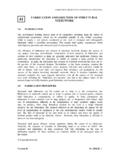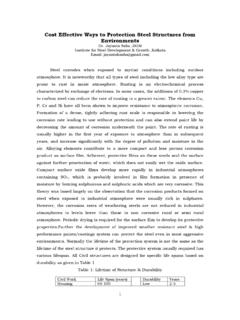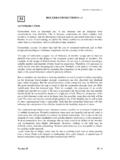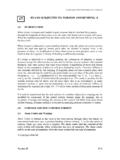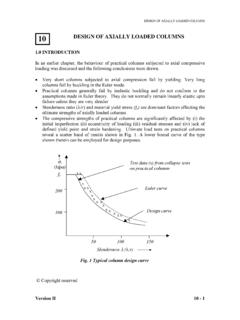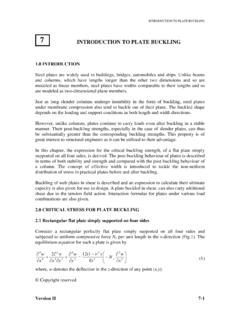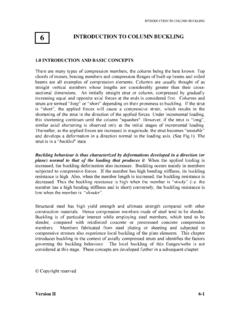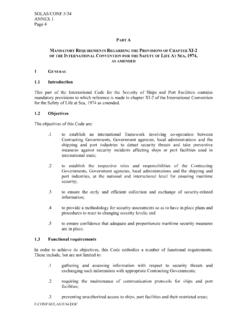Transcription of 27 TRUSSES - INSTITUTE FOR STEEL DEVELOPMENT & …
1 TRUSSES . 27 trusses . INTRODUCTION. TRUSSES are triangular frame works in which the members are subjected to essentially axial forces due to externally applied load. They may be plane TRUSSES [Fig. 1(a)], wherein the external load and the members lie in the same plane or space TRUSSES [Fig. 1(b)], in which members are oriented in three dimensions in space and loads may also act in any direction. TRUSSES are frequently used to span long lengths in the place of solid web girders and such TRUSSES are also referred to as lattice girders. (a) Plane Truss (b) Space Truss Rafter (Plan). Bracings Longitudinal Vertical (Wall) Bracings Transverse Vertical (wall). Bracings (c) Bracings in (d) Bracings in Single (e) Truss Bridge Multi-storey Building Storey Buildings Fig. 1 Types of TRUSSES STEEL members subjected to axial forces are generally more efficient than members in flexure since the cross section is nearly uniformly stressed.
2 TRUSSES , consisting of essentially axially loaded members, thus are very efficient in resisting external loads. They are extensively used, especially to span large gaps. Since truss systems consume relatively less material and more labour to fabricate, compared to other systems, they are particularly suited in the Indian context. Copyright reserved Version II 27 - 1. TRUSSES . TRUSSES are used in roofs of single storey industrial buildings, long span floors and roofs of multistory buildings, to resist gravity loads [Figs. 1(a) and 1(b)]. TRUSSES are also used in multi-storey buildings and walls and horizontal planes of industrial buildings to resist lateral loads and give lateral stability [Figs. 1(c) and 1(d)]. TRUSSES are used in long span bridges to carry gravity loads and lateral loads [Fig. 1(e)]. TRUSSES often serve the action of the girder in transferring the gravity load over larger span, and are referred to also as lattice girders.
3 Such lattice girders are usually deeper and much lighter than regular girders and hence are economical, particularly when repetitive fabrication is taken advantage of. These are used as flooring support systems in multi-storey buildings, within which depth all the ducts can be easily accommodated without increasing the depth of the ceiling. STEEL TRUSSES can also be efficiently used along with concrete slabs in buildings and bridges by mobilising composite action between structural STEEL and concrete. In this chapter, initially, the details of structural STEEL TRUSSES are discussed. Subsequently, the behaviour and design of structural STEEL - concrete composite TRUSSES are discussed. LOADS. The loads on TRUSSES would depend upon the application for which the TRUSSES are used. The loads may be static, as in the case of buildings, or dynamic, as in the case of bridges. These are briefly reviewed below. Industrial Buildings The roof TRUSSES in industrial buildings are subjected to the following loads: Dead load Dead load on the roof TRUSSES in single storey industrial buildings consists of dead load of claddings and dead load of purlins, self weight of the TRUSSES in addition to the weight of bracings etc.
4 Further, additional special dead loads such as truss supported hoist dead loads, special ducting and ventilator weight etc. could contribute to roof truss dead loads. As the clear span length (column free span length) increases, the self weight of the moment resisting gable frame increases drastically. In such cases roof TRUSSES are more economical. Live load The live load on roof TRUSSES consist of the gravitational load due to erection and servicing as well as dust load etc. and the intensity is taken as per IS:875-1987 (Reaffirmed 1992). Additional special live loads such as snow loads in very cold climates, crane live loads in TRUSSES supporting monorails may have to be considered. Version II 27 - 2. TRUSSES . Wind load Wind load on the roof TRUSSES , unless the roof slope is too high, would be usually uplift force perpendicular to the roof, due to suction effect of the wind blowing over the roof. Hence the wind load on roof truss usually acts opposite to the gravity load, and its magnitude can be larger than gravity loads, causing reversal of forces in truss members.
5 The horizontal and vertical bracings employed in single and multi-storey buildings are also TRUSSES [Fig. 1(d)], used primarily to resist wind and other lateral loads. These bracings minimize the differential deflection between the different frames due to crane surge in industrial buildings. They also provide lateral support to columns in small and tall buildings, thus increasing the buckling strength. Earthquake load Since earthquake load on a building depends on the mass of the building, earthquake loads usually do not govern the design of light industrial STEEL buildings. Wind loads usually govern. Howev er, in the case of industrial buildings with a large mass located at the roof, the earthquake load may govern the design. These loads are calculated as per IS:1893- 1985. Multi-Storey Buildings The lateral load due to wind or earthquake may be resisted by vertical bracings acting as TRUSSES . These bracings, properly designed, make these buildings very stiff in resisting lateral loads.
6 Hence they are economical in the buildings of intermediate height ranges. In the case of earthquake loading, stiff buildings may attract larger inertia force and hence use of bracings may not be desirable. Bridge TRUSSES TRUSSES are used in bridges to transfer the gravity load of moving vehicles to supporting piers. Depending upon the site conditions and the span length of the bridge, the truss may be either through type or deck type. In the through type, the carriage way is supported at the bottom chord of TRUSSES . In the deck type bridge, the carriage way is supported at the top chord of TRUSSES . Usually, the structural framing supporting the carriage way is designed such that the loads from the carriage way are transferred to the nodal points of the vertical bridge TRUSSES . More details of the TRUSSES bridges are discussed in the chapter on bridges. ANALYSIS OF TRUSSES . Generally truss members are assumed to be joined together so as to transfer only the axial forces and not moments and shears from one member to the adjacent members (they are Version II 27 - 3.)
7 TRUSSES . regarded as being pinned joints). The loads are assumed to be acting only at the nodes of the TRUSSES . The TRUSSES may be provided over a single span, simply supported over the two end supports, in which case they are usually statically determinate. Such TRUSSES can be analysed manually by the method of joints or by the method of sections. Computer programs are also available for the analysis of TRUSSES . These programs are more useful in the case of multi-span indeterminate TRUSSES , as well as in the case of TRUSSES in which the joint rigidity has to be considered. The effect of joint rigidity is discussed later in greater detail. From the analysis based on pinned joint assumption, one obtains only the axial forces in the different members of the TRUSSES . However, in actual design, the members of the TRUSSES are joined together by more than one bolt or by welding, either directly or through larger size end gussets.
8 Further, some of the members, particularly chord members, may be continuous over many nodes. Generally such joints enforce not only compatibility of translation but also compatibility of rotation of members meeting at the joint. As a result, the members of the TRUSSES experience bending moment in addition to axial force. This may not be negligible, particularly at the eaves points of pitched roof TRUSSES , where the depth is small and in TRUSSES with members having a smaller slenderness ratio ( stocky members). Further, the loads may be applied in between the nodes of the TRUSSES , causing bending of the members. Such stresses are referred to as secondary stresses. The secondary bending stresses can be caused also by the eccentric connection of members at the joints. The analysis of TRUSSES for the secondary moments and hence the secondary stresses can be carried out by an indeterminate structural analysis, usually using computer software.
9 The magnitude of the secondary stresses due to joint rigidity depends upon the stiffness of the joint and the stiffness of the members meeting at the joint. Normally the secondary stresses in roof TRUSSES may be disregarded, if the slenderness ratio of the chord members is greater than 50 and that of the web members is greater than 100. The secondary stresses cannot be neglected when they are induced due to application of loads on members in between nodes and when the members are joined eccentrically. Further the secondary stresses due to the rigidity of the joints cannot be disregarded in the case of bridge TRUSSES due to the higher stiffness of the members and the effect of secondary stresses on fatigue strength of members. In bridge TRUSSES , often misfit is designed into the fabrication of the joints to create prestress during fabrication opposite in nature to the secondary stresses and thus help improve the fatigue performance of the truss members at their joints.
10 CONFIGURATION OF TRUSSES . Pitched Roof TRUSSES Most common types of roof TRUSSES are pitched roof TRUSSES wherein the top chord is provided with a slope in order to facilitate natural drainage of rainwater and clearance of dust/snow accumulation. These TRUSSES have a greater depth at the mid-span. Due to this Version II 27 - 4. TRUSSES . even though the overall bending effect is larger at mid-span, the chord member and web member stresses are smaller closer to the mid-span and larger closer to the supports. The typical span to maximum depth ratios of pitched roof TRUSSES are in the range of 4 to 8, the larger ratio being economical in longer spans. Pitched roof TRUSSES may have different configurations. In Pratt TRUSSES [Fig. 2(a)] web members are arranged in such a way that under gravity load the longer diagonal members are under tension and the shorter vertical members experience compression. This allows for efficient design, since the short members are under compression.

